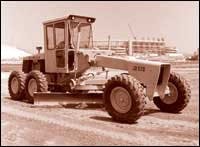Deere's JD570 featured a 12-foot standard blade, an operating weight of 20,278 pounds, and an 83-flywheel-hp John Deere diesel engine.
John Deere's first motor grader was big news in 1967. The revolutionary JD570 featured not only front-wheel steering, but also frame articulation, which caused a stir in the grader industry. Some questioned the need for two methods of steering. But contractors quickly realized the new machine's many advantages when they found it could work more effectively in confined areas.
The JD570's articulated frame combined with regular steering reduced the turning radius and allowed the operator to "crab steer" the grader into new operating configurations. Articulation allowed him to put the front wheels over a windrow, on a slope, or down in a ditch and still keep the rear drive wheels on solid footing. The articulated-frame concept became the standard of the industry as other manufacturers gradually developed similar designs. Now, with the exception of today's compact utility machine makers, all grader manufacturers offer articulated frame machines in their line.
That early grader featured a 12-foot standard blade, an operating weight of 20,278 pounds when equipped with cab and scarifier, and an 83-flywheel-hp John Deere diesel engine. Its full power-shift transmission provided eight speeds forward up to 21 mph and four reverse speeds. The machine also featured all-hydraulic blade movements including a horizontal side shift of six feet outside the wheels and blade positioning up to 90 degrees left or right for bank cutting capability. The all-hydraulic controls were also a breakthrough since they were arranged to work according to the operator's natural response. For instance, the 360-degree circle rotation was achieved by twisting a T-bar, and blade side shift was achieved by moving this T-bar right or left.
Although not meant to be a big high-production grader, the JD570 boasted all the blade movements of its bigger brothers, making its small size ideally suited to housing developments, industrial construction, and the many finishing jobs often necessary after the big machines moved on. It found a niche market before today's compact graders became available.
Deere added more sophisticated and larger graders to its product line, but the small JD570 was so successful it remained unaltered until 1972, and then only slightly modified to the JD570A. This model, with a bit more power and weight, enjoyed an even longer production run until 1986 when the improved 90-flywheel-hp JD570B grader took over.
You can read more about the evolution of construction equipment in Keith Haddock's illustrated book "The Earthmover Encyclopedia" available in most bookstores. Also, consider a membership in the Historical Construction Equipment Association, www.hcea.net.






